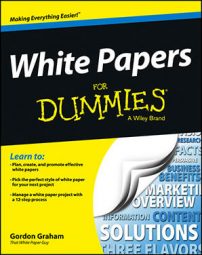Nothing undermines a good white paper faster than poor design. No matter how compelling and persuasive the text may be, if people can’t read it because of a poor design, they’ll quickly move on. Then all your effort and expense are for nothing.
Consider your readers’ eyesight when you design your white paper
Most people’s eyes begin to change in their 40s, and they start to need larger type to read comfortably. By coincidence, most B2B white papers are aimed at business decision makers, most of whom are in their 40s and older. And many people this age prefer to read on paper, so they likely print out a white paper rather than read it on-screen.
Younger designers, take note: You’re not designing white papers for yourself and your peers; you’re designing for older people.
That means forget gray text and color backgrounds. Black text on a white background has been the standard for legibility for hundreds of years; why change it? Forget 9-point type. Bump up the body size type to 10 or 11 points; it’s free. So what if your text spills to another page or two?
Respect the paragraph breaks the writer used and don’t eliminate them. Then leave a few points of white space after each paragraph to let it breathe. And if you see a paragraph running half a page long, ask the writer to break it into several shorter paragraphs. Give your older readers’ eyes some relief.
Realize that the text in your white paper isn’t a graphic
Many designers treat text like a graphic, like a photo, diagram, or block of color. They never read it, so they don’t realize that in a white paper, the text is the content.
Don’t just pour in the text around everything else, like it’s gray goo that’s supposed to ooze into all the spaces between the headings and pictures. Don’t look at a page like an industrial design, where all the chunks need to more or less balance each other.
Look at your pages as text-driven content, where your challenge is to make the text as inviting and easy to read or scan as in any magazine you pick up.
As a white paper designer, your goal is to do effective editorial design, not display design. Display is for advertising, packaging, web splash pages, and retail store windows. Editorial design is for pages to be read. Here’s a tip: Try actually reading your pages after you design them. If you want to stop reading, take a hint and redo that page to make the text easier to read.
Make every page in your white paper count
Sure, every white paper needs a little front and back matter, but when the front and back matter add up to nearly two-thirds of a white paper, something is terribly wrong.
One mistake is leaving a page completely blank, or even worse, inserting a blank page covered in nothing but some theme color. Some misguided software templates lay out a white paper like a two-sided book, with a blank page on the back of the front cover and a back cover to tie it all together.
Forget it! Most B2B buyers either look at your white paper on-screen or print it out single sided. Those other pages are just a waste of time and money.
Imagine all the people printing your white paper with those extra pages. You’ve just wasted hundreds or thousands of pieces of paper covered with very expensive ink or toner. Even if people view your document on-screen, you’ve still given them an empty expanse to scroll through. So be sure to compress the front and back matter, cut the worthless blank pages, and make every page count.
Control hyphenation in your white paper
Most software does a terrible job of hyphenating English. If you let it, it will break words like sy-stem, Or-acle, and Ac-me. Traditional typography called for at least four letters before any hyphen and at least three letters carried to the second line.
Most typographers wouldn’t hyphenate a word with fewer than six letters. So don’t rely on automated hyphenation, and leave your text ragged right. Then scan your right margins, and if you see a major white space that you absolutely must eliminate, take two seconds to insert a manual hyphen.
You can split a word by its sounds, syllables, or root words. Try using some combination of all three, and, if possible, create recognizable root words by inserting optional hyphens. For example, in the word thankfully, the most sensible places to put a hyphen are thank-fully or thankful-ly. This simple tactic builds readability instead of tearing it down with meaningless breaks.
Refine a corporate template for your white paper
Some companies have a corporate template that they expect all designers to follow. These layouts may be perfect for a press release, an internal business report, or a data sheet, but they’re not always ideal for a white paper. Remember, standards do evolve, and they can be changed.
If the corporate template detracts from the readability and undermines the white paper content, make your views known. If you have the scope, make up two versions of the white paper: one following the existing template and another with your recommended changes. Circulate both versions to your team, your customer advisory board, and your manager.
Get a second opinion from an experienced designer or a white paper expert. Hopefully, good sense and good taste will prevail and your corporate template is refined to present your white paper in the best possible format.

